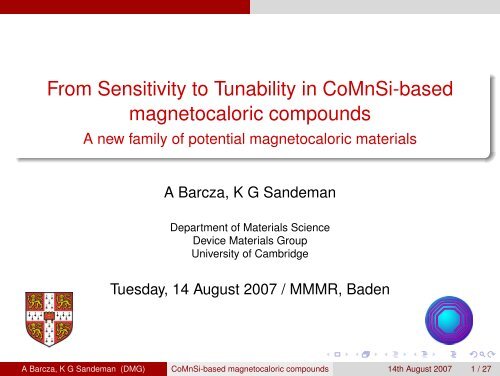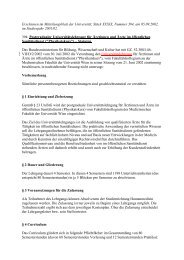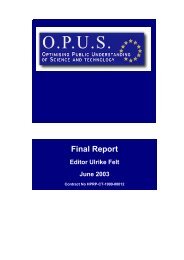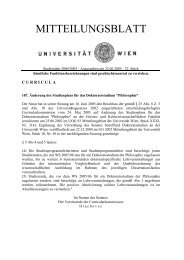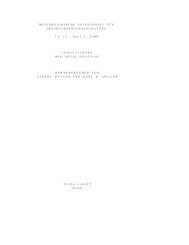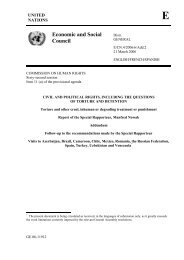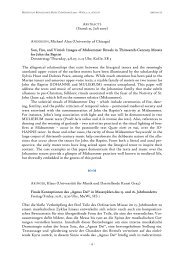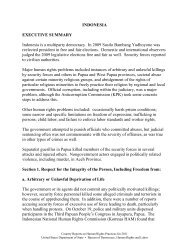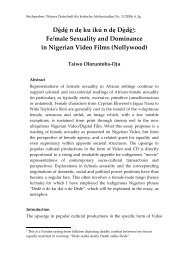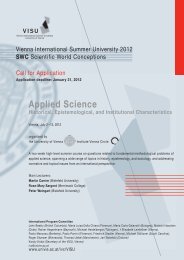Alexander Barcza
Alexander Barcza
Alexander Barcza
Create successful ePaper yourself
Turn your PDF publications into a flip-book with our unique Google optimized e-Paper software.
From Sensitivity to Tunability in CoMnSi-based<br />
magnetocaloric compounds<br />
A new family of potential magnetocaloric materials<br />
A <strong>Barcza</strong>, K G Sandeman<br />
Department of Materials Science<br />
Device Materials Group<br />
University of Cambridge<br />
Tuesday, 14 August 2007 / MMMR, Baden<br />
A <strong>Barcza</strong>, K G Sandeman (DMG) CoMnSi-based magnetocaloric compounds 14th August 2007 1 / 27
Outline<br />
1 Introduction<br />
Motivation<br />
Inverse/negative magnetocaloric effect<br />
Thermodynamic quantities describing the magnetocaloric effect<br />
The magnetocaloric effect in metamagnets<br />
2 CoMnSi-based metamagnets<br />
CoMnSi<br />
CoMnSi1−xGex<br />
CoMn1−xNixSi<br />
3 Summary and Outlook<br />
A <strong>Barcza</strong>, K G Sandeman (DMG) CoMnSi-based magnetocaloric compounds 14th August 2007 2 / 27
Why use Mn based alloys?<br />
Mn based compounds are:<br />
relatively cheap<br />
Introduction Motivation<br />
environmentally friendly (not all of them)<br />
show first-order phase transitions (as well as higher order)<br />
MnAs 1) , TC = 318 K, ∆SM = −32 J kg −1 K −1 in 5 T<br />
Mn1.1Fe0.9P0.47As0.53 2) : TC 310 K, ∆SM = −20 J kg −1 K −1 in 5 T<br />
Ni0.5Mn0.5−xSnx 3) : Tt 300 K ∆SM = 18 J kg −1 K −1 in 5 T<br />
(x=0.13)<br />
Mn3GaC 4) : Tt = 164 K, ∆SM = 12 J kg −1 K −1 in 5 T<br />
properties are tunable by substitution of elements<br />
exchange interactions between Mn-Mn are crucial for magnetism of<br />
Mn-based compounds<br />
1) Wada H, Appl. Phys. Lett. 79 3302-3304 (2001)<br />
2) Tegus O, J. Magn. Magn. Mater. 272 2389-2390 (2004)<br />
3) Krenke T, Nature Mat. 4 450-454 (2005)<br />
4) Tohai T, J. Appl. Phys. 94 1800-1802 (2003)<br />
A <strong>Barcza</strong>, K G Sandeman (DMG) CoMnSi-based magnetocaloric compounds 14th August 2007 3 / 27
Studied inverse MCE materials<br />
Introduction Inverse/negative magnetocaloric effect<br />
Mn2Sb 1) is ferrimagnet with T C=550 K<br />
two Mn sites with different magnetic moments<br />
substitution of Mn with Cr/V leads to first order antiferro- to<br />
ferrimagnetic transition<br />
Mn1.95Cr0.05Sb 2) : ∆SM = 7 J kg −1 K −1 in 5 T at ∼198 K<br />
Mn1.82V0.18Sb 3) : ∆SM = 5.5 J kg −1 K −1 in 5 T at ∼280 K<br />
Fe0.49Rh0.51 4) :<br />
highest observed inverse MCE of 20 J kg −1 K −1 at ∆H = 1.95 T<br />
MCE declines when material is cycled through phase transition<br />
1) Wijngaard J H, Phys. Rev. B 45 5395-5405 (1992) (and references therein)<br />
2) Tegus O, Physica B 319 174-192 (2002)<br />
3) Zhang Y Q, J. Alloys and Compounds 365 35-38 (2004)<br />
4) Annaorazov et al. J. Appl. Phys. 79 1689 (1996)<br />
A <strong>Barcza</strong>, K G Sandeman (DMG) CoMnSi-based magnetocaloric compounds 14th August 2007 4 / 27
Inverse MCE in FeRh<br />
Kouvel J S J. Appl. Phys. 37 1257 (1966)<br />
Annaorazov et al. J. Appl. Phys. 79 1689 (1996)<br />
Introduction Inverse/negative magnetocaloric effect<br />
first order magnetostructural phase<br />
transition from antiferro- to<br />
ferromagnetic state at 330 K for FeRh<br />
development of magnetic moment on<br />
Rh at the phase transition<br />
crystal volume changes at the phase<br />
transition ∼ 0.3 % [2]<br />
spontaneous magnetostriction is a<br />
measure for lattice entropy<br />
contributions<br />
A <strong>Barcza</strong>, K G Sandeman (DMG) CoMnSi-based magnetocaloric compounds 14th August 2007 5 / 27
Introduction Thermodynamic quantities describing the magnetocaloric effect<br />
Isothermal entropy change ∆ST and adiabatic temperature change ∆Tad<br />
∆ST =<br />
H2<br />
H 1<br />
<br />
H2<br />
∂M<br />
dH ∆Tad = −<br />
∂T p,H<br />
H1 T<br />
CH,p<br />
∆Tad and ∆ST are large near a phase transition,<br />
<br />
∂M<br />
dH<br />
∂T p,H<br />
the sharper the phase transition the larger ∆Tad and ∆ST ,<br />
∆Tad and ∆ST are larger for higher magnetic fields.<br />
For application in a room temperature magnetic refrigerator materials<br />
should have<br />
phase transitions around room temperature and a large MCE,<br />
phase transition that can be induced in small magnetic fields,<br />
should be environmentally friendly and cheap.<br />
A <strong>Barcza</strong>, K G Sandeman (DMG) CoMnSi-based magnetocaloric compounds 14th August 2007 6 / 27
Introduction Thermodynamic quantities describing the magnetocaloric effect<br />
Isothermal entropy change ∆ST and adiabatic temperature change ∆Tad<br />
∆ST =<br />
H2<br />
H 1<br />
<br />
H2<br />
∂M<br />
dH ∆Tad = −<br />
∂T p,H<br />
H1 T<br />
CH,p<br />
∆Tad and ∆ST are large near a phase transition,<br />
<br />
∂M<br />
dH<br />
∂T p,H<br />
the sharper the phase transition the larger ∆Tad and ∆ST ,<br />
∆Tad and ∆ST are larger for higher magnetic fields.<br />
For application in a room temperature magnetic refrigerator materials<br />
should have<br />
phase transitions around room temperature and a large MCE,<br />
phase transition that can be induced in small magnetic fields,<br />
should be environmentally friendly and cheap.<br />
A <strong>Barcza</strong>, K G Sandeman (DMG) CoMnSi-based magnetocaloric compounds 14th August 2007 6 / 27
Metamagnets as refrigerants<br />
M<br />
S T<br />
(∂M/∂T) > 0<br />
H<br />
H =0<br />
T t<br />
H 1<br />
T C<br />
Introduction The magnetocaloric effect in metamagnets<br />
T<br />
T<br />
Remember:<br />
H2<br />
∆Tad =<br />
H1 ∆ST =<br />
− T<br />
<br />
∂M<br />
dH<br />
CH,p ∂T p,H<br />
H2<br />
A <strong>Barcza</strong>, K G Sandeman (DMG) CoMnSi-based magnetocaloric compounds 14th August 2007 7 / 27<br />
H 1<br />
<br />
∂M<br />
dH<br />
∂T p,H<br />
At a metamagnetic transition<br />
∆ST is positive,<br />
∆Tad is negative.
CoMnSi-based metamagnets CoMnSi<br />
The metamagnet – CoMnSi<br />
sample was quenched from 1000 ◦ C<br />
60.0<br />
M (Am 2 /kg)<br />
50.0<br />
40.0<br />
30.0<br />
20.0<br />
10.0<br />
4000 Oe<br />
0.0<br />
100 200 300 400 500 600<br />
T (K)<br />
Bińczycka et al., phys. stat. sol. (a) 35 K69 (1976)<br />
Johnson et al., phys. stat. sol (a) 20 331 (1973)<br />
Nizioł et al., phys. stat. sol. (a) 45 591 (1978)<br />
There are 3 phase transitions in CoMnSi<br />
antiferro- to ferromagnetic<br />
(metamagnetic) phase transition<br />
at Tt = 200 − 360 K,<br />
ferro- to paramagnetic phase<br />
transition at T C 410 K,<br />
orthorhombic to hexagonal<br />
structural phase transition at<br />
Tstructural = 917 ◦ C.<br />
! phase transition temperatures are very<br />
sample dependent !<br />
A <strong>Barcza</strong>, K G Sandeman (DMG) CoMnSi-based magnetocaloric compounds 14th August 2007 8 / 27
CoMnSi-based metamagnets CoMnSi<br />
The metamagnet – CoMnSi<br />
sample was quenched from 1000 ◦ C<br />
60.0<br />
M (Am 2 /kg)<br />
50.0<br />
40.0<br />
30.0<br />
20.0<br />
10.0<br />
4000 Oe<br />
0.0<br />
100 200 300 400 500 600<br />
T (K)<br />
Bińczycka et al., phys. stat. sol. (a) 35 K69 (1976)<br />
Johnson et al., phys. stat. sol (a) 20 331 (1973)<br />
Nizioł et al., phys. stat. sol. (a) 45 591 (1978)<br />
There are 3 phase transitions in CoMnSi<br />
antiferro- to ferromagnetic<br />
(metamagnetic) phase transition<br />
at Tt = 200 − 360 K,<br />
ferro- to paramagnetic phase<br />
transition at T C 410 K,<br />
orthorhombic to hexagonal<br />
structural phase transition at<br />
Tstructural = 917 ◦ C.<br />
! phase transition temperatures are very<br />
sample dependent !<br />
A <strong>Barcza</strong>, K G Sandeman (DMG) CoMnSi-based magnetocaloric compounds 14th August 2007 8 / 27
CoMnSi-based metamagnets CoMnSi<br />
The metamagnet – CoMnSi<br />
sample was quenched from 1000 ◦ C<br />
60.0<br />
M (Am 2 /kg)<br />
50.0<br />
40.0<br />
30.0<br />
20.0<br />
10.0<br />
4000 Oe<br />
0.0<br />
100 200 300 400 500 600<br />
T (K)<br />
Bińczycka et al., phys. stat. sol. (a) 35 K69 (1976)<br />
Johnson et al., phys. stat. sol (a) 20 331 (1973)<br />
Nizioł et al., phys. stat. sol. (a) 45 591 (1978)<br />
There are 3 phase transitions in CoMnSi<br />
antiferro- to ferromagnetic<br />
(metamagnetic) phase transition<br />
at Tt = 200 − 360 K,<br />
ferro- to paramagnetic phase<br />
transition at T C 410 K,<br />
orthorhombic to hexagonal<br />
structural phase transition at<br />
Tstructural = 917 ◦ C.<br />
! phase transition temperatures are very<br />
sample dependent !<br />
A <strong>Barcza</strong>, K G Sandeman (DMG) CoMnSi-based magnetocaloric compounds 14th August 2007 8 / 27
CoMnSi1−xGex-system<br />
Nizioł et al., J. Magn. Magn. Mat. 79 333-337 (1989)<br />
CoMnSi-based metamagnets CoMnSi 1−x Gex<br />
Objectives in making CoMnSi1−xGex:<br />
change sample composition and<br />
gain control over Tt<br />
separate Tt and T C<br />
measure the magnetocaloric effect<br />
A <strong>Barcza</strong>, K G Sandeman (DMG) CoMnSi-based magnetocaloric compounds 14th August 2007 9 / 27
CoMnSi-based metamagnets CoMnSi 1−x Gex<br />
Magnetization M(H) and MCE of CoMnSi1−xGex<br />
Ge substitution decreases the metamagnetic transition temperature<br />
transition is sharpest in CoMnSi0.95Ge0.05 yielding ∆ST=9 J kg −1 K −1<br />
at ∆H = 5 T<br />
change of sign around room temperature<br />
Sandeman et al., Phys. Rev. B 74 224436 (2006)<br />
A <strong>Barcza</strong>, K G Sandeman (DMG) CoMnSi-based magnetocaloric compounds 14th August 2007 10 / 27
CoMnSi-based metamagnets CoMnSi 1−x Gex<br />
Magnetization M(H) and MCE of CoMnSi1−xGex<br />
Ge substitution decreases the metamagnetic transition temperature<br />
transition is sharpest in CoMnSi0.95Ge0.05 yielding ∆ST=9 J kg −1 K −1<br />
at ∆H = 5 T<br />
change of sign around room temperature<br />
interested in the microscopic magnetization?<br />
– see next talk by Kelly Morrison<br />
Sandeman et al., Phys. Rev. B 74 224436 (2006)<br />
A <strong>Barcza</strong>, K G Sandeman (DMG) CoMnSi-based magnetocaloric compounds 14th August 2007 10 / 27
CoMn1−xNixSi – Aims<br />
CoMnSi-based metamagnets CoMn 1−x Nix Si<br />
Objectives of making Ni substituted CoMn1−xNixSi are<br />
increase T C, far away from Tt<br />
tune Tt near room temperature<br />
obtain large values for ∆Tad and ∆ST<br />
get single phase material<br />
A <strong>Barcza</strong>, K G Sandeman (DMG) CoMnSi-based magnetocaloric compounds 14th August 2007 11 / 27
CoMnSi-based metamagnets CoMn 1−x Nix Si<br />
Synthesis and characterization of CoMn1−xNixSi<br />
quasi contact free co-melting of elements in an induction furnace,<br />
subsequent annealing of ingots in a box furnace at 1123 - 1373 K,<br />
measurement of structural transition temperatures with<br />
calorimetry,<br />
determination of crystal structure with X-ray powder diffraction,<br />
magnetic measurements with VSM and SQUID<br />
A <strong>Barcza</strong>, K G Sandeman (DMG) CoMnSi-based magnetocaloric compounds 14th August 2007 12 / 27
CoMnSi-based metamagnets CoMn 1−x Nix Si<br />
High temperature structural transition temperatures<br />
heating:<br />
cooling:<br />
Thermal analysis (SDT) signals for heating (upper<br />
figure) and cooling (lower figure):<br />
Ni (%) T heating<br />
struc T cooling<br />
7 926<br />
struc<br />
842 84<br />
9 924 846 78<br />
11 920 826 94<br />
∆Tstruc<br />
value of Tstruc is important to choose<br />
annealing conditions<br />
three different hold temperatures were<br />
choosen (850 ◦ C, 950 ◦ C, 1100 ◦ C)<br />
all samples were slowly cooled<br />
A <strong>Barcza</strong>, K G Sandeman (DMG) CoMnSi-based magnetocaloric compounds 14th August 2007 13 / 27
CoMnSi-based metamagnets CoMn 1−x Nix Si<br />
Crystal structure of CoMn1−xNixSi<br />
orthorhombic Pnma phase with<br />
TiNiSi-type structure<br />
a=5.83 Å, b=3.68 Å, c=6.86 Å<br />
atoms in Wyckoff pos. 4c (x, 1<br />
4 , z)<br />
not all reflections belong to the space<br />
group Pnma<br />
ac-plane viewed along b-axis of the orthorhombic unit cell<br />
Mn (pink), Co (blue), Si (yellow)<br />
atom x y z<br />
Co 0.159(1) 0.250000 0.559(1)<br />
Mn 0.015(2) 0.250000 0.184(1)<br />
Ni 0.015(2) 0.250000 0.184(1)<br />
Si 0.773(3) 0.250000 0.620(2)<br />
A <strong>Barcza</strong>, K G Sandeman (DMG) CoMnSi-based magnetocaloric compounds 14th August 2007 14 / 27
CoMnSi-based metamagnets CoMn 1−x Nix Si<br />
Second hexagonal crystallographic phase<br />
high temperature hexagonal<br />
structure is metastable at room<br />
temperature<br />
hexagonal P63/mmc phase with<br />
Ni2In type<br />
a=3.93 Å, c=5.22 Å<br />
ac-plane viewed along b-axis of the orthorhombic unit cell<br />
Mn in ( 1 3 , 2 3 , 3 4 ) (pink), Co in ( 1 3 , 2 3 , 1 ) (blue), Si in (0, 0, 0)<br />
4<br />
(yellow)<br />
axis-transformation during orthorhombic to hexagonal unit cell<br />
transition:<br />
a =<br />
hex b ortho<br />
A <strong>Barcza</strong>, K G Sandeman (DMG) CoMnSi-based magnetocaloric compounds 14th August 2007 15 / 27<br />
a hex<br />
1/2<br />
3<br />
a = hex<br />
c ortho
CoMnSi-based metamagnets CoMn 1−x Nix Si<br />
A metastable high temperature hexagonal phase<br />
amount of second phase:<br />
weight fraction of hexagonal Phase (%)<br />
24<br />
22<br />
20<br />
18<br />
16<br />
14<br />
12<br />
10<br />
8<br />
6<br />
4<br />
2<br />
Annealing temperature<br />
1100 °C<br />
950 °C<br />
850 °C<br />
0<br />
6 8 10 12<br />
degree of Ni substitution (%)<br />
unit cell volume:<br />
147.4<br />
6 8 10 12<br />
degree of Ni substitution (%)<br />
annealing at a temperature below Tstruc for a long time<br />
(200 h) decreases the weight fraction of second phase<br />
samples annealed away from Tstruc show similar<br />
behaviour of unit cell volume versus Ni concentration<br />
orthorhombic unit cell volume (Å 3 )<br />
A <strong>Barcza</strong>, K G Sandeman (DMG) CoMnSi-based magnetocaloric compounds 14th August 2007 16 / 27<br />
147.9<br />
147.8<br />
147.7<br />
147.6<br />
147.5<br />
Annealing temperature<br />
1100 °C<br />
950 °C<br />
850 °C (Si powder)
CoMnSi-based metamagnets CoMn 1−x Nix Si<br />
Magnetization M(H) of CoMn1−xNixSi at low<br />
temperatures<br />
M (Am 2 /kg)<br />
140.0<br />
120.0<br />
100.0<br />
80.0<br />
60.0<br />
40.0<br />
20.0<br />
330 K<br />
CoMn 0.93 Ni 0.07 Si<br />
70 K<br />
330 K<br />
280 K<br />
250 K<br />
230 K<br />
210 K<br />
190 K<br />
170 K<br />
150 K<br />
130 K<br />
110 K<br />
90 K<br />
70 K<br />
0.0<br />
0 1 2 3 4 5<br />
µ H (T)<br />
0<br />
sample was annealed at 950 ◦ C<br />
at low temperatures there are<br />
two regions where magnetization<br />
changes<br />
metamagnetic phase transition<br />
at ∼3 T<br />
A <strong>Barcza</strong>, K G Sandeman (DMG) CoMnSi-based magnetocaloric compounds 14th August 2007 17 / 27
CoMnSi-based metamagnets CoMn 1−x Nix Si<br />
Magnetization M(H) of CoMn1−xNixSi at low<br />
temperatures<br />
M (Am 2 /kg)<br />
140.0<br />
120.0<br />
100.0<br />
80.0<br />
60.0<br />
40.0<br />
20.0<br />
330 K<br />
CoMn 0.93 Ni 0.07 Si<br />
70 K<br />
330 K<br />
280 K<br />
250 K<br />
230 K<br />
210 K<br />
190 K<br />
170 K<br />
150 K<br />
130 K<br />
110 K<br />
90 K<br />
70 K<br />
0.0<br />
0 1 2 3 4 5<br />
µ H (T)<br />
0<br />
sample was annealed at 950 ◦ C<br />
at low temperatures there are<br />
two regions where magnetization<br />
changes<br />
metamagnetic phase transition<br />
at ∼3 T<br />
Does the second phase have an influence on M(H)?<br />
A <strong>Barcza</strong>, K G Sandeman (DMG) CoMnSi-based magnetocaloric compounds 14th August 2007 17 / 27
CoMnSi-based metamagnets CoMn 1−x Nix Si<br />
Curie transitions above room temperature<br />
samples annealed at 850 ◦ C<br />
Ni (%) T C1 (K)<br />
7 431<br />
9 437<br />
11 445<br />
two transitions at temperatures<br />
above room temperature<br />
relative drop of magnetization<br />
above T C1 corresponds to the<br />
amount of second phase<br />
T C increases with Ni content<br />
A <strong>Barcza</strong>, K G Sandeman (DMG) CoMnSi-based magnetocaloric compounds 14th August 2007 18 / 27
CoMnSi-based metamagnets CoMn 1−x Nix Si<br />
The magnetocaloric effect in CoMn1−xNixSi<br />
magnetisation data<br />
M (Am 2 /kg)<br />
140.0<br />
120.0<br />
100.0<br />
80.0<br />
60.0<br />
40.0<br />
20.0<br />
330 K<br />
CoMn 0.93 Ni 0.07 Si<br />
70 K<br />
330 K<br />
280 K<br />
250 K<br />
230 K<br />
210 K<br />
190 K<br />
170 K<br />
150 K<br />
130 K<br />
110 K<br />
90 K<br />
70 K<br />
0.0<br />
0 1 2 3 4 5<br />
µ H (T)<br />
0<br />
second hexagonal phase was<br />
identified to be ferromagnetic.<br />
magnetic field induced<br />
metamagnetic phase transition<br />
at ∼3 T (70 K).<br />
from M versus T curves: Tt<br />
around 170 K in 1 T.<br />
T C of both phases are above<br />
430 K<br />
isothermal magnetisation versus magnetic field curves were used to<br />
calculate the magnetocaloric effect<br />
A <strong>Barcza</strong>, K G Sandeman (DMG) CoMnSi-based magnetocaloric compounds 14th August 2007 19 / 27
CoMnSi-based metamagnets CoMn 1−x Nix Si<br />
The magnetocaloric effect in CoMn1−xNixSi<br />
Temperature dependence of ∆ST at various Ni concentrations<br />
M (Am 2 /kg)<br />
∆ S T (Jkg -1 K -1 )<br />
140.0<br />
120.0<br />
100.0<br />
80.0<br />
60.0<br />
40.0<br />
20.0<br />
0.0<br />
3.0<br />
2.5<br />
2.0<br />
1.5<br />
1.0<br />
0.5<br />
0.0<br />
-0.5<br />
11 %<br />
CoMn 0.91 Ni 0.09 Si<br />
1 2 3 4 5<br />
µ H (T)<br />
CoMn 0 Ni Si 1-x x<br />
9 %<br />
7 %<br />
330 K<br />
280 K<br />
250 K<br />
230 K<br />
210 K<br />
190 K<br />
170 K<br />
150 K<br />
130 K<br />
110 K<br />
90 K<br />
70 K<br />
M (Am 2 /kg)<br />
0 50 100 150 200 250<br />
T (K)<br />
140.0<br />
120.0<br />
100.0<br />
80.0<br />
60.0<br />
40.0<br />
20.0<br />
0.0<br />
330 K<br />
10 K<br />
CoMn 0.89 Ni 0.11 Si<br />
1 2 3 4 5<br />
µ 0 H (T)<br />
maximal entropy change ∼2.5 J/kgK<br />
in a magnetic field change from 0 -<br />
5 T at ∼100 K<br />
∆ST decreases with Ni concentration<br />
ferromagnetic background of second<br />
phase has negative influence<br />
A <strong>Barcza</strong>, K G Sandeman (DMG) CoMnSi-based magnetocaloric compounds 14th August 2007 20 / 27<br />
330 K<br />
280 K<br />
250 K<br />
230 K<br />
210 K<br />
190 K<br />
170 K<br />
150 K<br />
130 K<br />
110 K<br />
90 K<br />
70 K<br />
50 K<br />
30 K<br />
10 K
CoMnSi-based metamagnets CoMn 1−x Nix Si<br />
Order of the metamagnetic phase transition<br />
7 %<br />
M 2 (Am 2 /kg) 2<br />
9 %<br />
M 2 (Am 2 /kg) 2<br />
11 %<br />
M 2 (Am 2 /kg) 2<br />
20000<br />
18000<br />
16000<br />
14000<br />
12000<br />
10000<br />
8000<br />
6000<br />
4000<br />
2000<br />
20000<br />
18000<br />
16000<br />
14000<br />
12000<br />
330 K<br />
CoMn 0.93 Ni 0.07 Si<br />
70 K<br />
330 K<br />
280 K<br />
250 K<br />
230 K<br />
210 K<br />
190 K<br />
170 K<br />
150 K<br />
130 K<br />
110 K<br />
90 K<br />
70 K<br />
0.00 0.01 0.02 0.03 0.04<br />
µ H/M (T kg/ Am<br />
0<br />
0.05 0.06<br />
2 0<br />
CoMn Ni Si )<br />
0.91 0.09<br />
0.00 0.01 0.02 0.03 0.04 0.05<br />
µ H/M (T kg/Am<br />
0<br />
0.06 0.07<br />
2 10000<br />
330 K<br />
280 K<br />
8000<br />
250 K<br />
230 K<br />
210 K<br />
6000<br />
190 K<br />
170 K<br />
4000<br />
150 K<br />
130 K<br />
2000<br />
110 K<br />
90 K<br />
70 K<br />
0<br />
CoMn Ni Si)<br />
0.89 0.11<br />
20000<br />
18000<br />
16000<br />
14000<br />
12000<br />
10000<br />
8000<br />
6000<br />
4000<br />
2000<br />
330 K<br />
10 K<br />
330 K<br />
280 K<br />
250 K<br />
230 K<br />
210 K<br />
190 K<br />
170 K<br />
150 K<br />
130 K<br />
110 K<br />
90 K<br />
70 K<br />
50 K<br />
30 K<br />
10 K<br />
0.00 0.01 0.02 0.03 0.04<br />
µ H/M (T kg/Am<br />
0<br />
0.05 0.06<br />
2 0<br />
)<br />
around phase transitions thermodynamic potentials<br />
can be expanded in a Taylor series with respect<br />
to the order parameter:<br />
Φ = Φ0 + aM 2 + bM 4 − MH<br />
at equilibrium (∂Φ/∂M = 0):<br />
αM + βM 3 = H −→ H<br />
M<br />
= α + βM2<br />
<br />
≥ 0, higher order phase transitions<br />
β<br />
< 0, first order phase transitions<br />
Banerjee S K, Phys. Lett. 12 16 (1964)<br />
A <strong>Barcza</strong>, K G Sandeman (DMG) CoMnSi-based magnetocaloric compounds 14th August 2007 21 / 27
Summary<br />
Summary and Outlook<br />
Samples of CoMn1−xNixSi with x = 0.07, 0.09, 0.11 were<br />
synthesised.<br />
A second ferromagnetic phase was identified and partial control<br />
over it was obtained.<br />
Maximum ∆ST of 2.5 J/kgK at 100 K in 5 T was calculated from<br />
isothermal M(H) curves.<br />
A <strong>Barcza</strong>, K G Sandeman (DMG) CoMnSi-based magnetocaloric compounds 14th August 2007 22 / 27
Conclusion<br />
Conclusion and further work<br />
Values for ∆ST are too small at a too low temperature for room<br />
temperature applications.<br />
Second phase broadens the metamagnetic phase transition and<br />
decreases the magnetocaloric effect.<br />
Further work<br />
Employment of element and crystallographic phase specific<br />
experimental techniques to study the influence of the second phase<br />
(SEM with EBSD, XPEEM).<br />
Try other substitutions (e.g. Ni on the Co site and Cr on the Mn<br />
site).<br />
A <strong>Barcza</strong>, K G Sandeman (DMG) CoMnSi-based magnetocaloric compounds 14th August 2007 23 / 27
Conclusion<br />
Conclusion and further work<br />
Values for ∆ST are too small at a too low temperature for room<br />
temperature applications.<br />
Second phase broadens the metamagnetic phase transition and<br />
decreases the magnetocaloric effect.<br />
Further work<br />
Employment of element and crystallographic phase specific<br />
experimental techniques to study the influence of the second phase<br />
(SEM with EBSD, XPEEM).<br />
Try other substitutions (e.g. Ni on the Co site and Cr on the Mn<br />
site).<br />
A <strong>Barcza</strong>, K G Sandeman (DMG) CoMnSi-based magnetocaloric compounds 14th August 2007 23 / 27
Acknowledgements<br />
Acknowledgements<br />
Karl G. Sandeman for supervising me and my work.<br />
Sibel Özcan for sample synthesis.<br />
Mary E. Vickers and Andrew Moss for a lot of help with X-ray<br />
diffraction and data analysis.<br />
EPSRC and Camfridge Ltd. for funding.<br />
A <strong>Barcza</strong>, K G Sandeman (DMG) CoMnSi-based magnetocaloric compounds 14th August 2007 24 / 27
Appendix<br />
A <strong>Barcza</strong>, K G Sandeman (DMG) CoMnSi-based magnetocaloric compounds 14th August 2007 25 / 27
Appendix<br />
A <strong>Barcza</strong>, K G Sandeman (DMG) CoMnSi-based magnetocaloric compounds 14th August 2007 26 / 27
Appendix<br />
A <strong>Barcza</strong>, K G Sandeman (DMG) CoMnSi-based magnetocaloric compounds 14th August 2007 27 / 27


